Unlocking the Vision: A Drone Mapping Utility for Every City
Aerial Data powered by drones can transform urban governance.
THOUGHT-PAPER
Prayush
6/7/20254 min read


Executive Summary
Imagine a city where the pulse of urban life is mapped, monitored, and managed with pinpoint precision—where every street, building, park, and pipeline is regularly surveyed by a fleet of drones. This is the vision behind the Drone Mapping Utility (DMU): a city-wide, regulated service responsible for the repetitive, high-resolution mapping of urban environments and the provision of actionable drone data to all stakeholders. Funded via a nominal per-square-foot charge on property taxes and overseen by a Civilian Monitoring Drone Authority (CMDA), the DMU promises to revolutionize urban management, catalyze industry growth, create jobs, and unlock a new data-driven economy for cities.
The Need for a Drone Mapping Utility
Urban areas are expanding at an unprecedented rate. Between 1992 and 2016, the global urban land area more than doubled, and projections suggest another 1.2 million km² of new urban land by 2030. Traditional methods of urban mapping—ground surveys, satellite imagery, and manual inspections—are slow, expensive, and often outdated. As cities grow more complex, the need for real-time, accurate, and actionable spatial data becomes critical for infrastructure planning, disaster management, environmental monitoring, and efficient public services.
The DMU Model: Structure and Funding
What is the DMU?
The Drone Mapping Utility is a city-sanctioned entity equipped with advanced drones and mapping software. Its core mandate is to perform repetitive, scheduled mapping missions across the entire city, producing high-resolution imagery, 3D models, topographic maps, and specialized datasets (e.g., vegetation health, infrastructure integrity, traffic flows).
How is it funded?
The DMU’s operations are funded by a small, transparent per-square-foot charge added to property taxes. This model ensures a sustainable revenue stream, democratizes access to high-quality geospatial data, and aligns the utility’s incentives with the public good.
Who regulates it?
Oversight is provided by the Civilian Monitoring Drone Authority (CMDA), a multi-stakeholder body including city officials, industry representatives, citizen advocates, and privacy experts. The CMDA sets operational standards, enforces privacy and safety regulations, and ensures equitable data access.
Transformational Benefits
1. Industry Development and Innovation
· Catalyst for New Businesses: Open access to city-scale, up-to-date drone data lowers barriers for startups and established firms in sectors like construction, real estate, logistics, insurance, and environmental services.
· Smart City Enablement: DMU data feeds urban digital twins, supports AI-driven planning tools, and underpins next-gen smart city applications—from traffic optimization to predictive maintenance of infrastructure.
· Stimulus for Drone Ecosystem: Regular, large-scale mapping contracts drive demand for drone manufacturers, software developers, and data analysts, fostering a vibrant local drone industry.
2. Job Creation
· Direct Employment: DMUs require skilled pilots, data scientists, GIS specialists, maintenance crews, and regulatory compliance officers.
· Indirect Employment: The downstream effects include jobs in urban planning, construction, utilities, disaster response, and environmental monitoring—fields that increasingly rely on high-quality spatial data.
· Upskilling Opportunities: Training programs and certification standards established by the CMDA ensure a pipeline of qualified professionals, supporting workforce development and social mobility.
3. Revenue Generation and Economic Growth
· Unlocking the Drone Data Economy: The global drone data services market is projected to grow at over 39% CAGR, reaching billions in value by 2030. Cities can license anonymized, aggregated data to commercial users, creating new public revenue streams.
· Cost Savings: Automated mapping reduces the need for expensive, labor-intensive ground surveys, saving municipalities millions annually while improving accuracy and coverage.
· Attracting Investment: Reliable, high-frequency urban data attracts investors and tech companies seeking to pilot new services and products in data-rich environments.
4. Overcoming Current Challenges
· Data Fragmentation: Today, urban drone data is siloed among private operators, limiting its utility. The DMU centralizes data collection, standardizes formats, and ensures interoperability, fostering a unified citywide digital infrastructure.
· Regulatory Complexity: The CMDA streamlines compliance with airspace, privacy, and safety regulations, providing a single point of contact for operators and the public.
· Access and Equity: By funding the DMU through property taxes, all city stakeholders—public agencies, businesses, and citizens—benefit from access to critical data, not just those who can afford private surveys.
· Privacy and Security: The CMDA enforces strict protocols for data anonymization, storage, and access, balancing the benefits of open data with the need to protect individual privacy.
Real-World Impact: Use Cases
· Urban Planning: Planners use DMU data for zoning, land use optimization, and infrastructure design, leveraging centimeter-level accuracy for better outcomes.
· Disaster Management: Rapid drone mapping after floods, fires, or earthquakes enables real-time damage assessment and targeted emergency response.
· Infrastructure Monitoring: Utilities and public works departments monitor bridges, roads, pipelines, and water systems, identifying maintenance needs before failures occur.
· Environmental Monitoring: Regular mapping tracks green cover, air quality, water bodies, and urban heat islands, supporting sustainability initiatives.
· Public Safety: Law enforcement and civil defense agencies use drone data for crowd management, surveillance of high-risk areas, and post-incident analysis.
Addressing Implementation Challenges
· Initial Investment: While setup costs for drones, software, and training are significant, the long-term savings and value creation far outweigh the upfront expenditure.
· Data Management: The DMU must invest in robust cloud infrastructure and analytics platforms to handle large data volumes and deliver actionable insights.
· Weather and Operational Limits: Drones are subject to weather constraints; the DMU schedules flights accordingly and maintains a diverse fleet for resilience.
· Community Engagement: Transparent communication and public participation in the CMDA build trust and ensure the utility serves the city’s needs.
A Vision for the Future
The Drone Mapping Utility model transforms cities into living, breathing digital organisms—where every change is mapped, every risk is monitored, and every opportunity for improvement is visible in real time. By institutionalizing drone mapping as a public utility, cities can leapfrog legacy challenges, foster innovation, and build more resilient, efficient, and inclusive urban environments.
As the drone data economy matures, the DMU will be the backbone of smart city ecosystems, enabling everything from autonomous vehicles to climate resilience planning. The per-square-foot funding model ensures sustainability and equity, while the CMDA guarantees oversight, safety, and privacy.
In summary:
A regulated, citywide Drone Mapping Utility—funded by property taxes and governed by a multi-stakeholder authority—will unlock unprecedented value for industry, government, and citizens alike. It will drive economic growth, create jobs, and provide the foundation for the next generation of urban innovation.
The future of cities is airborne, mapped, and data-driven. The time to build the Drone Mapping Utility is now.


Helpful Links
Join Us Online
Want to learn more?
Copyright © Kesowa Infinite Ventures Private Limited
Subscribe to our newsletter for the latest features and updates.
By subscribing, you consent to our Privacy Policy and receive updates.
